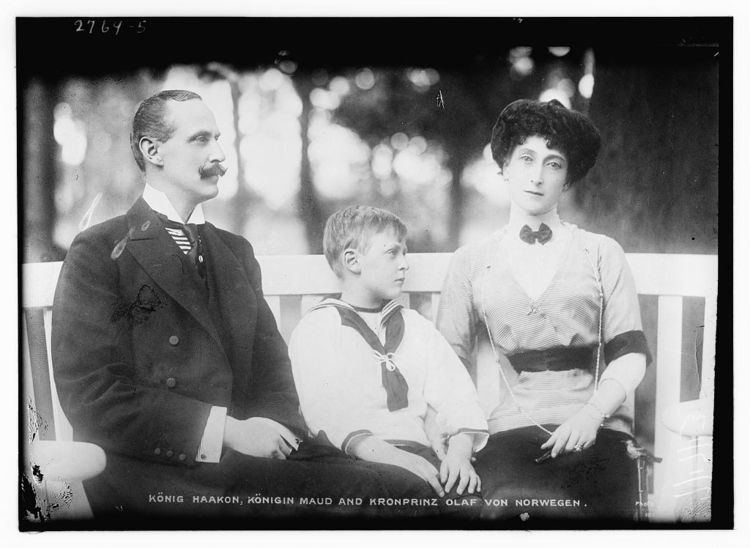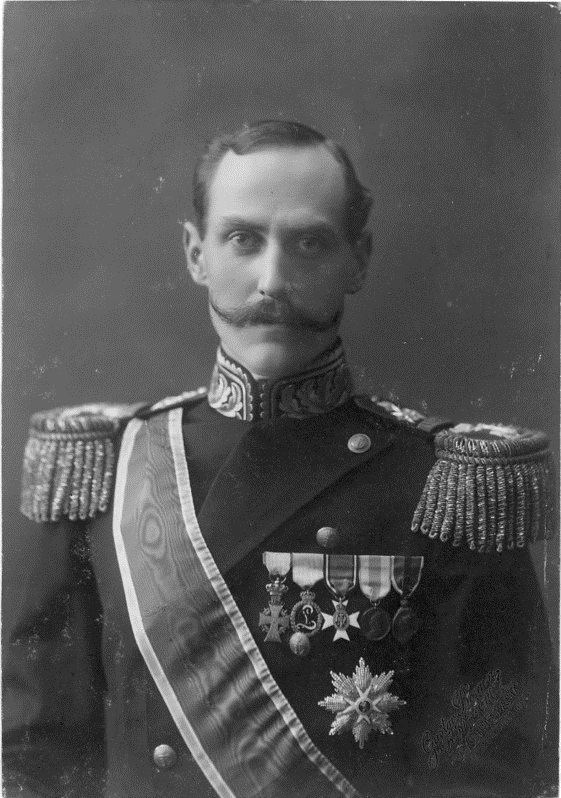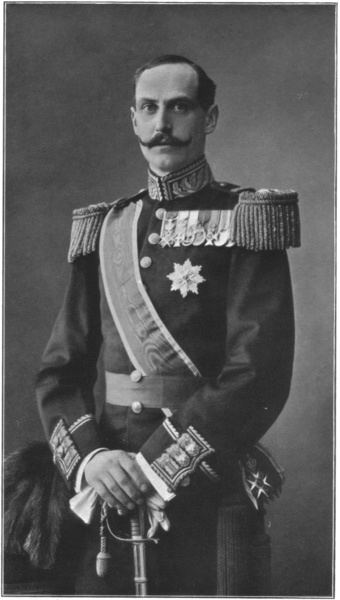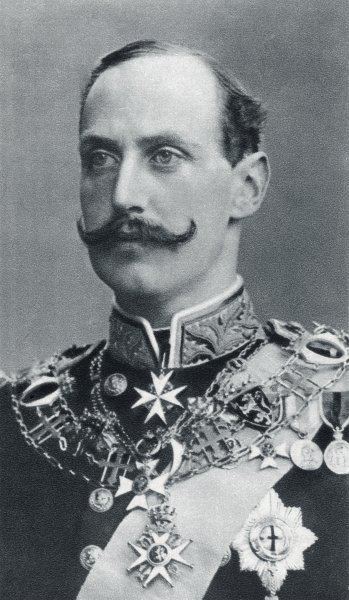Coronation 22 June 1906 Name Christian Axel Predecessor Oscar II Role Prince | Children Olav V of Norway Siblings Christian X of Denmark | |
 | ||
Full name Christian Frederik Carl Georg Valdemar Axel Reign 18 November 1905 − 21 September 1957 Burial 1 October 1957Akershus Fortress, Oslo Died September 21, 1957, Oslo, Norway Parents Frederick VIII of Denmark, Louise of Sweden Similar People Maud of Wales, Olav V of Norway, Harald V of Norway, Princess Martha of Sweden, Frederick VIII of Denmark | ||
Haakon VII Of Norway
Haakon VII ([hɔːkɔn]; born Christian Frederik Carl Georg Valdemar Axel; 3 August 1872 – 21 September 1957), known as Prince Carl of Denmark until 1905, was a Danish prince who became the first king of Norway after the 1905 dissolution of the union with Sweden. He reigned from November 1905 until his death in September 1957.
Contents
- Haakon VII Of Norway
- Nine Kings in One Photo 1910 Kaiser Wilhelm II King George V Alfonso XIII
- Family and early life
- Background and election
- Reign
- The German invasion
- Government in exile
- Post war years
- Titles and styles
- Honours
- In popular culture
- Ancestry
- References

As one of the few elected monarchs, Haakon quickly won the respect and affection of his people. He played a pivotal role in uniting the Norwegian nation in its resistance to the German invasion and subsequent five-year-long occupation of his country during World War II. Regarded as one of the greatest Norwegians of the twentieth century, he is particularly revered for his courage during the German invasion—he threatened abdication if the government cooperated with the invading Germans—and for his leadership and preservation of Norwegian unity during the occupation.

He became King of Norway before his father and older brother became kings of Denmark. During his reign, he saw his father, his brother and his nephew, Frederick IX, ascend the throne of Denmark, respectively in 1906, 1912 and 1947. He died at the age of 85 on 21 September 1957, after having reigned for nearly 52 years. He was succeeded by his only son, Olav V.

Nine Kings in One Photo (1910) Kaiser Wilhelm II, King George V, Alfonso XIII, ...
Family and early life

Prince Carl of Denmark (namesake of his maternal grandfather the King of Sweden-Norway) was the second son of (the future) King Frederik VIII of Denmark and his wife Louise. Furthermore, he was a younger brother of Christian X, a paternal grandson of King Christian IX of Denmark, and a maternal grandson of King Charles XV of Sweden (who was also king of Norway as Charles IV).
Prince Carl was born at Charlottenlund Palace near Copenhagen. He belonged to the Schleswig-Holstein-Sonderburg-Glücksburg branch of the House of Oldenburg. The House of Oldenburg had been the Danish royal family since 1448; between 1536–1814 it also ruled Norway when it was part of the Kingdom of Denmark-Norway. The house was originally from northern Germany, where the Glucksburg (Lyksborg) branch held their small fief. The family had permanent links with Norway beginning from the late Middle Ages. Several of his paternal ancestors had been kings of independent Norway (Haakon V of Norway, Christian I of Norway, Frederick I, Christian III, Frederick II, Christian IV, as well as Frederick III of Norway who integrated Norway into the Oldenburg state with Denmark, Schleswig and Holstein, after which it was not independent until 1814). Christian Frederick, who was King of Norway briefly in 1814, the first king of the Norwegian 1814 constitution and struggle for independence, was his great-granduncle.
Prince Carl was raised in the royal household in Copenhagen and educated at the Royal Danish Naval Academy from 1889 to 1893, graduating as a second lieutenant in the Royal Danish Navy. In 1894 he was promoted to the rank of first lieutenant and remained in service with the Royal Danish Navy until 1905.
At Buckingham Palace on 22 July 1896, Prince Carl married his first cousin Princess Maud of Wales, youngest daughter of the future King Edward VII of the United Kingdom and his wife, Princess Alexandra of Denmark, eldest daughter of King Christian IX of Denmark and Princess Louise of Hesse-Kassel. Their son, Prince Alexander, the future Crown Prince Olav (and eventually king Olav V of Norway), was born on 2 July 1903.
Background and election
After the Union between Sweden and Norway was dissolved in 1905, a committee of the Norwegian government identified several princes of European royal houses as candidates to become Norway's first king of its own since 1387. Gradually, Prince Carl became the leading candidate, largely because he was descended from independent Norwegian kings. He also had a son, providing an heir-apparent to the throne, and the fact that his wife, Princess Maud, was a member of the British Royal Family was viewed by many as an advantage to the newly independent Norwegian nation.
The democratically-minded Carl, aware that Norway was still debating whether to remain a kingdom or to switch instead to a republican system of government, was flattered by the Norwegian government's overtures, but he made his acceptance of the offer conditional on the holding of a referendum to show whether monarchy was the choice of the Norwegian people.
After the referendum overwhelmingly confirmed by a 79 percent majority (259,563 votes for and 69,264 against) that Norwegians desired to retain a monarchy, Prince Carl was formally offered the throne of Norway by the Storting (parliament) and was elected on 18 November 1905. When Carl accepted the offer that same evening (after the approval of his grandfather Christian IX of Denmark), he immediately endeared himself to his adopted country by taking the Old Norse name of Haakon, a name which had not been used by kings of Norway for over 500 years. In so doing, he succeeded his great-uncle, Oscar II of Sweden, who had abdicated the Norwegian throne in October following the agreement between Sweden and Norway on the terms of the separation of the union.
The new royal family of Norway left Denmark on the Danish royal yacht Dannebrog and sailed into Oslofjord. At Oscarsborg Fortress, they boarded the Norwegian naval ship Heimdal. After a three-day journey, they arrived in Kristiania (now Oslo) early on the morning of 25 November 1905. Two days later, Haakon took the oath as Norway's first independent king in 518 years.
The coronation of Haakon and Maud took place in Nidaros Cathedral in Trondheim on 22 June 1906.
Reign
King Haakon gained much sympathy from the Norwegian people. He traveled extensively through Norway.
Although the Constitution of Norway vests the King with considerable executive powers, in practice nearly all major governmental decisions were made by the Government (the Council of State) in his name. Haakon confined himself to non-partisan roles without interfering in politics, a practice continued by his son and grandson. However, his long rule gave him considerable moral authority as a symbol of the country's unity.
Haakon, Maud and Crown Prince Olav became interested in skiing. This sport is often viewed as typically Norwegian. They were often seen with their skis while on tour. Olav later became a champion in ski jumping.
The Norwegian explorer and Nobel Prize laureate Fridtjof Nansen became a friend of the Royal Family.
In 1928, the Labour Party became the majority in parliament and Norway's first Labour Party government rose to power. This party was found to be "revolutionary" by many and the deputy prime minister at the time advised against appointing Christian Hornsrud as Prime Minister. Haakon, however, refused to abandon parliamentary convention and asked Hornsrud to form a new government. In response to some of his detractors he stated, "I am also the King of the Communists" (Norwegian: "Jeg er også kommunistenes konge").
Crown Prince Olav married his cousin Princess Märtha of Sweden on 21 March 1929. She was the daughter of Haakon's sister Ingeborg and Prince Carl, Duke of Västergötland. Olav and Märtha had three children: Ragnhild (1930–2012), Astrid (b. 1932) and Harald (b. 1937), who was to become king in 1991.
Queen Maud died on 20 November 1938.
The German invasion
Norway was invaded by the naval and air forces of Nazi Germany during the early hours of 9 April 1940. The German naval detachment sent to capture Oslo was opposed by Oscarsborg Fortress. The fortress fired at the invaders, sinking the heavy cruiser Blücher and damaging the heavy cruiser Lützow, with heavy German losses that included many of the armed forces, Gestapo agents, and administrative personnel who were to have occupied the Norwegian capital. This led to the withdrawal of the rest of the German flotilla, preventing the invaders from occupying Oslo at dawn as had been planned. The German delay in occupying Oslo, along with swift action by the President of the Storting, C. J. Hambro, created the opportunity for the Norwegian Royal Family, the cabinet, and most of the 150 members of the Storting (parliament) to make a hasty departure from the capital by special train.
The Storting first convened at Hamar the same afternoon, but with the rapid advance of German troops, the group moved on to Elverum. The assembled Storting unanimously enacted a resolution, the so-called Elverum Authorization, granting the cabinet full powers to protect the country until such time as the Storting could meet again.
The next day, Curt Bräuer, the German Minister to Norway, demanded a meeting with Haakon. The German diplomat called on Haakon to accept Adolf Hitler's demands to end all resistance and appoint Vidkun Quisling as prime minister. Quisling, the leader of Norway's fascist party, the Nasjonal Samling, had declared himself prime minister hours earlier in Oslo as head of what would be a German puppet government; had Haakon formally appointed him, it would have effectively given legal sanction to the invasion. Bräuer suggested that Haakon follow the example of the Danish government and his brother, Christian X, which had surrendered almost immediately after the previous day's invasion, and threatened Norway with harsh reprisals if it did not surrender. Haakon told Bräuer that he could not make the decision himself, but only on the advice of the Government. While Haakon would have been well within his rights to make such a decision on his own authority (since declaring war and peace are part of the royal prerogative), even at this critical hour he refused to abandon the convention that he acted on the Government's advice.
In an emotional meeting in Nybergsund, the King reported the German ultimatum to his cabinet. While Haakon could not make the decision himself, he knew he could use his moral authority to influence it. Accordingly, Haakon told the cabinet:
I am deeply affected by the responsibility laid on me if the German demand is rejected. The responsibility for the calamities that will befall people and country is indeed so grave that I dread to take it. It rests with the government to decide, but my position is clear.
For my part I cannot accept the German demands. It would conflict with all that I have considered to be my duty as King of Norway since I came to this country nearly thirty-five years ago.
Haakon went on to say that he could not appoint Quisling as Prime Minister because he knew neither the people nor the Storting had confidence in him. However, if the cabinet felt otherwise, the King said he would abdicate so as not to stand in the way of the Government's decision.
Nils Hjelmtveit, Minister of Church and Education, later wrote:
This made a great impression on us all. More clearly than ever before, we could see the man behind the words; the king who had drawn a line for himself and his task, a line from which he could not deviate. We had through the five years [in government] learned to respect and appreciate our king, and now, through his words, he came to us as a great man, just and forceful; a leader in these fatal times to our country.
Inspired by Haakon's stand, the Government unanimously advised him not to appoint any government headed by Quisling. Within hours, it telephoned its refusal to Bräuer. That night, NRK broadcast the government's rejection of the German demands to the Norwegian people. In that same broadcast, the Government announced that it would resist the German invasion as long as possible, and expressed their confidence that Norwegians would lend their support to the cause.
Government in exile
The following morning, 11 April 1940, in an attempt to wipe out Norway's unyielding king and government, Luftwaffe bombers attacked Nybergsund, destroying the small town where the Government was staying. Neutral Sweden was only 16 miles away, but the Swedish government decided it would "detain and incarcerate" King Haakon if he crossed their border (which Haakon never forgave). The Norwegian king and his ministers took refuge in the snow-covered woods and escaped harm, continuing farther north through the mountains toward Molde on Norway's west coast. As the British forces in the area lost ground under Luftwaffe bombardment, the King and his party were taken aboard the British cruiser HMS Glasgow at Molde and conveyed a further 1,000 kilometres (620 mi) north to Tromsø, where a provisional capital was established on 1 May. Haakon and Crown Prince Olav took up residence in a forest cabin in Målselvdalen valley in inner Troms County, where they would stay until evacuation to the United Kingdom. While residing in Tromsø, the two were protected by local rifle association members armed with the ubiquitous Krag-Jørgensen rifle.
The Allies had a fairly secure hold over northern Norway until late May. The situation was dramatically altered, however, by their deteriorating situation in the Battle of France. With the Germans rapidly overrunning France, the Allied high command decided that the forces in northern Norway should be withdrawn. The Royal Family and Norwegian Government were evacuated from Tromsø on 7 June aboard HMS Devonshire with a total of 461 passengers. This evacuation became extremely costly for the Royal Navy when the German warships Scharnhorst and Gneisenau attacked and sank the nearby aircraft carrier HMS Glorious with its escorting destroyers HMS Acasta and HMS Ardent. Devonshire did not rebroadcast the enemy sighting report made by Glorious as she could not disclose her position by breaking radio silence. No other British ship received the sighting report, and 1,519 British officers and men and three warships were lost. Devonshire arrived safely in London and King Haakon and his Cabinet set up a Norwegian government in exile in the British capital.
Initially, King Haakon and Crown Prince Olav were guests at Buckingham Palace, but at the start of the London Blitz in September 1940, they moved to Bowdown House in Berkshire. The construction of the adjacent RAF Greenham Common airfield in March 1942 prompted another move to Foliejon Park in Winkfield, near Windsor, in Berkshire, where they remained until the liberation of Norway. The King's official residence was the Norwegian Legation at 10 Palace Green, Kensington, which became the seat of the Norwegian government in exile. Here Haakon attended weekly Cabinet meetings and worked on the speeches which were regularly broadcast by radio to Norway by the BBC World Service. These broadcasts helped to cement Haakon's position as an important national symbol to the Norwegian resistance. Many broadcasts were made from Saint Olav's Norwegian Church in Rotherhithe, where the Royal Family were regular worshippers.
Meanwhile, Hitler had appointed Josef Terboven as Reichskommissar for Norway. On Hitler's orders, Terboven attempted to coerce the Storting to depose the King; the Storting declined, citing constitutional principles. A subsequent ultimatum was made by the Germans, threatening to intern all Norwegians of military age in German concentration camps. With this threat looming, the Storting's representatives in Oslo wrote to their monarch on 27 June, asking him to abdicate. The King declined, politely replying that the Storting was acting under duress. The King gave his answer on 3 July, and proclaimed it on BBC radio on 8 July.
After one further German attempt in September to force the Storting to depose Haakon failed, Terboven finally decreed that the Royal Family had "forfeited their right to return" and dissolved the democratic political parties.
During Norway's five years under German control, many Norwegians surreptitiously wore clothing or jewellery made from coins bearing Haakon's "H7" monogram as symbols of resistance to the German occupation and of solidarity with their exiled King and Government, just as many people in Denmark wore his brother's monogram on a pin. The King's monogram was also painted and otherwise reproduced on various surfaces as a show of resistance to the occupation.
After the end of the war, Haakon and the Norwegian Royal Family returned to Norway aboard the cruiser HMS Norfolk, arriving with the First Cruiser Squadron to cheering crowds in Oslo on 7 June 1945, exactly five years after they had been evacuated from Tromsø.
Post-war years
In 1947, the Norwegian people, by public subscription, purchased the royal yacht Norge for the King. (In 2012 it was one of only two remaining Royal Yachts belonging to European monarchs; the other, Dannebrog, belongs to the Queen of Denmark, the King's niece).
In 1952, he attended the funeral of his nephew King George VI and openly wept. (His two nephews and one niece on his wife's side had died: Prince John in 1919, Prince George, Duke of Kent in 1942 and Princess Maud, Countess of Southesk in 1945.)
The King's granddaughter, Princess Ragnhild, married businessman Erling Lorentzen (of the Lorentzen family) on 15 May 1953, being the first member of the Norwegian royal family to marry a commoner. Haakon saw two of his great-grandchildren born, Haakon Lorentzen (b. 23 August 1954) and Ingeborg Lorentzen (b. 3 February 1957).
Crown Princess Märtha died on 5 April 1954, after suffering from cancer.
King Haakon VII fell in his bathroom at the estate at Bygdøy in July 1955. This fall, which occurred just a month before his eighty-third birthday, resulted in a fracture to the thighbone and, although there were few other complications resulting from the fall, the King was left using a wheelchair. The once-active King was said to have been depressed by his resulting helplessness and began to lose his customary involvement and interest in current events. With Haakon's loss of mobility, and as his health deteriorated further in the summer of 1957, Crown Prince Olav appeared on behalf of his father on ceremonial occasions and took a more active role in state affairs.
At Haakon's death on September 21, 1957, Olav succeeded as Olav V. Haakon was buried on 1 October 1957. He and Maud rest in the white sarcophagus in the Royal Mausoleum at Akershus Fortress. He was the last surviving son of King Frederick VIII of Denmark.
Today, King Haakon VII is regarded by many as one of the greatest Norwegian leaders of the pre-war period, managing to hold his young and fragile country together in unstable political conditions.
Titles and styles
Titles and styles which Haakon VII bore from birth to death, in chronological order:
Haakon VII was the last of Norway's Kings to have the style by the Grace of God (Norwegian: av Guds nåde).
Honours
The King Haakon VII Sea in East Antarctica is named in the king's honour as well as the entire plateau surrounding the South Pole was named King Haakon VII Vidde by Roald Amundsen when he in 1911 became the first human to reach the South Pole. See Polheim. In 1914 Haakon County in the American state of South Dakota was named in his honor.
Two Royal Norwegian Navy ships – King Haakon VII, an escort ship in commission from 1942 to 1951, and Haakon VII, a training ship in commission from 1958 to 1974—have been named after King Haakon VII.
For his struggles against the Nazi regime and his effort to revive the Holmenkollen ski festival following World War II, King Haakon VII earned the Holmenkollen medal in 1955 (Shared with Hallgeir Brenden, Veikko Hakulinen, and Sverre Stenersen), one of only eleven people not famous for Nordic skiing to receive this honour. (The others are Norway's Stein Eriksen, Borghild Niskin, Inger Bjørnbakken, Astrid Sandvik, King Olav V (his son), Erik Håker, Jacob Vaage, King Harald V (his paternal grandson), and Queen Sonja (his paternal granddaughter-in-law), and Sweden's Ingemar Stenmark).
His father-in-law King Edward VII appointed him Honorary Lieutenant in the British Fleet shortly after succeeding in February 1901.
Other honours:
In popular culture
Haakon was portrayed by Jesper Christensen in the 2016 film The King's Choice which was based on the events surrounding the German invasion of Norway and the King's decision to resist. The film won widespread critical acclaim and was nominated for an academy award.
Ancestry
Through his father, he was a nephew of Queen Alexandra of the United Kingdom, Empress Maria Feodorovna of Russia and King George I of Greece. Amongst his cousins were King Constantine I of Greece, King George V of the United Kingdom and the Emperor Nicholas II of Russia.
